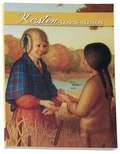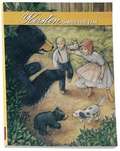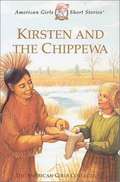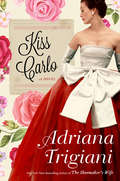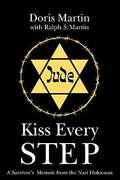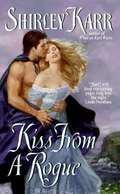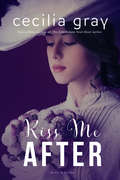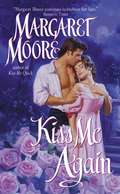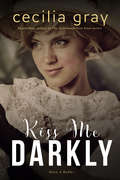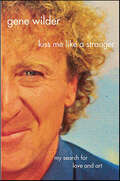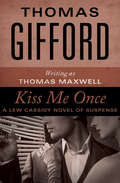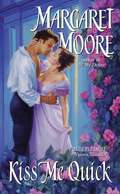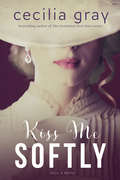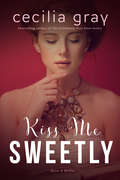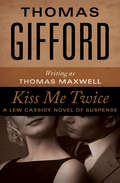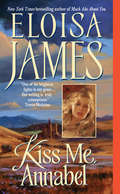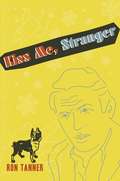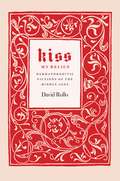- Table View
- List View
Kirsten Learns a Lesson: A School Story (American Girls #2)
by Janet ShawKirsten has a hard time in her new American school because she doesn't speak English very well. Miss Winston, her new teacher, is strict and not very understanding. Things get worse when Miss Winston comes to live with the Larson family. Kirsten's only escape is playing with her secret friend Singing Bird, the Indian girl. When Singing Bird suggests running away forever, Kirsten must decide where she belongs. Kirsten does learn some important lessons in school, but she learns something even more important about herself.
Kirsten Saves the Day: A Summer Story (American Girls #5)
by Janet Shaw"At last it's summer! Even Kirsten's chores, like going to the stream to catch fish for dinner, seem like play in the fine Minnesota weather. One day while she's fishing, Kirsten leaves the stream to explore the woods beyond the farm. <P><P>There she finds a treasure-a bee tree packed with honeycombs. Kirsten knows Papa could use the honey to trade for things the family needs. So she decides to surprise him by bringing the honey home. Kirsten needs help, so she asks her brother Peter to go with her. But they don't know that bears are after Kirsten's treasure, too." <P><P> Bookshare also has "Meet Kirsten," "Kirsten's Surprise," and "Kirsten Learns a Lesson." <P><P> This file should make a fine embossed braille copy.
Kirsten and The Chippewa (American Girls Short Stories #21)
by Janet ShawWhen Kirsten Kirsten's dog is about to drown, a group of Indians rescue him for her. She had been frightened of the Ojibway, but she learns that they are friendly people. This book includes notes on the history relevant to this story and a good and easy recipe for Bird's nest Pudding. This is a wonderful book for a book report. This file should make an excellent embossed braille copy.
Kirsten's Surprise: A Christmas Story (American Girls #3)
by Janet ShawKirsten wants her first Christmas in America to be special for her family. She would like to recreate St. Lucia's Day, a tradition celebrated in Sweden on Christmas Eve. To do this she needs costumes from a trunk in another town. Will she convince her father to get the trunk even though it's a long journey by horse-drawn sleigh in the bitter cold?
Kirtland Temple: The Biography of a Shared Mormon Sacred Space
by David J. HowlettThe only temple completed by Mormonism's founder, Joseph Smith Jr., the Kirtland Temple in Kirtland, Ohio, receives 30,000 Mormon pilgrims every year. Though the site is sacred to all Mormons, the temple's religious significance and the space itself are contested by rival Mormon dominations: its owner, the relatively liberal Community of Christ, and the larger Church of Jesus Christ of Latter-day Saints. David J. Howlett sets the biography of Kirtland Temple against the backdrop of religious rivalry. The two sides have long contested the temple's ownership, purpose, and significance in both the courts and Mormon literature. Yet members of each denomination have occasionally cooperated to establish periods of co-worship, host joint tours, and create friendships. Howlett uses the temple to build a model for understanding what he calls parallel pilgrimage--the set of dynamics of disagreement and alliance by religious rivals at a shared sacred site. At the same time, he illuminates social and intellectual changes in the two main branches of Mormonism since the 1830s, providing a much-needed history of the lesser-known Community of Christ.
Kismet
by Monica BurnsRaised in a brothel, Allegra Synnford quickly learned that survival meant taking charge of her destiny. Now, as a renowned courtesan skilled in the pleasures of the flesh, she chooses her lovers carefully-vowing never to be vulnerable to any one man. Until a mesmerizing, enigmatic Sheikh strips that control from her...
Kiss Carlo: A Novel
by Adriana Trigiani<p>From Adriana Trigiani, the beloved New York Times-bestselling author of The Shoemaker’s Wife, comes an exhilarating epic novel of love, loyalty, and creativity—the story of an Italian-American family on the cusp of change.</p> <p>It’s 1949 and South Philadelphia bursts with opportunity during the post-war boom. The Palazzini Cab Company & Western Union Telegraph Office, owned and operated by Dominic Palazzini and his three sons, is flourishing: business is good, they’re surrounded by sympathetic wives and daughters-in-law, with grandchildren on the way. <P> But a decades-long feud that split Dominic and his brother Mike and their once-close families sets the stage for a re-match. Amidst the hoopla, the arrival of an urgent telegram from Italy upends the life of Nicky Castone (Dominic and his wife’s orphaned nephew) who lives and works with his Uncle Dom and his family. Nicky decides, at 30, that he wants more—more than just a job driving Car #4 and more than his longtime fiancée Peachy DePino, a bookkeeper, can offer. <P>When he admits to his fiancée that he’s been secretly moonlighting at the local Shakespeare theater company, Nicky finds himself drawn to the stage, its colorful players and to the determined Calla Borelli, who inherited the enterprise from her father, Nicky must choose between the conventional life his family expects of him or chart a new course and risk losing everything he cherishes.</p> <p>From the dreamy mountaintop village of Roseto Valfortore in Italy, to the vibrant streets of South Philly, to the close-knit enclave of Roseto, Pennsylvania, to New York City during the birth of the golden age of television, Kiss Carlo is a powerful, inter-generational story that celebrates the ties that bind, while staying true to oneself when all hope seems lost. <P>Told against the backdrop of some of Shakespeare’s greatest comedies, this novel brims with romance as long buried secrets are revealed, mistaken identities are unmasked, scores are settled, broken hearts are mended and true love reigns. Trigiani’s consummate storytelling skill and her trademark wit, along with a dazzling cast of characters will enthrall readers. <P>Once again, the author has returned to her own family garden to create an unforgettable feast. Kiss Carlo is a jubilee, resplendent with hope, love, and the abiding power of la famiglia.</p> <P><b>A New York Times Bestseller</b>
Kiss Every Step: A Survivor's Memoir from the Nazi Holocaust
by Doris Martin Ralph S. MartinIn 1939 most Jewish families in Bendzin, and rest of Poland were completely wiped out by the Holocaust. The Szpringers were just an ordinary middle-class family, but through many incredible strokes of luck, or perhaps miracles, all seven of them survived.
Kiss From a Rogue
by Shirley KarrA woman of the night . . . Her inherited estate is bankrupt, but Lady Sylvia Montgomery will never allow the townsfolk who depend on her to starve. Desperate times call for desperate measures, and the plucky beauty reluctantly assumes the leadership of a smuggling operation--a mantle that fits her surprisingly well. However, the perilous enterprise may be more than one resourceful, genteel lady can manage alone. Luckily, help is on the way--in a most deliciously enticing masculine form! A rogue in training . . . Stripped of all familial responsibilities when his brother, the earl, returns from war, Anthony Sinclair has decided to become a rakehell. His pursuit of pleasure has led him to a village with a secret--and to an intoxicating lady involved in criminal activities. By rights, he should simply seduce the wench, have his way with her, then vanish. But the bewitching Sylvia has captured Tony's heart. And to win her love he will join her in turbulent and dangerously exciting waters where no true rake would ever venture.
Kiss Me After
by Cecilia GrayA brand new series from the author of The Gentlemen Next Door, praised for being a "delightful Regency romp... in the spirit of Georgette Heyer."Meet Alice Belle--the Bossy Belle--used to getting her way. If anyone has to fall on the matrimonial sword it will be she and not her sisters. She has set her sights on the richest, most titled gentlemen in her acquaintance. The perfect man to make her father happy, leaving her beloved sisters free to marry whom they choose.Meet Robert Crawford--ringleader--used to masterminding his way. If anyone is going to marry Alice Belle, it is he. Never mind that he's poor, without a title, and completely unsuitable for Alice in the eyes of her father. He loves her. Which makes him the perfect man to make her happy, whether she realizes it or not.* * *ABOUT THE KISS A BELLE SERIESFive supportive sisters.Five friendly gentlemen.Five stolen kisses.Everyone has kissed someone, but who has kissed whom?Secrets of the past will become very much present as arrangements are made and proposals fly in this charming, Regency-style series. While all of the stories can be enjoyed as standalones, you may want to read them all. Books 1-3 occur concurrently and can be read in any order; Books 4 and 5 follow respectively.Book 1: Kiss Me AfterBook 2: Kiss Me DarklyBook 3: Kiss Me SweetlyBook 4: Kiss Me SoftlyBook 5:Kiss Me Again
Kiss Me Again
by Cecilia GrayA brand new series from the author of The Gentlemen Next Door, praised for being a "delightful Regency romp... in the spirit of Georgette Heyer."Meet Charlotte Belle--the Bovine Belle--who has made a career of being utterly unremarkable. The middle and forgotten child, she is completely unseen, until he sees her. Not that it matters, because the only thing worse than falling in love is doing so with someone who can never love you back.* * *ABOUT THE KISS A BELLE SERIESFive supportive sisters.Five friendly gentlemen.Five stolen kisses.Everyone has kissed someone, but who has kissed whom?Secrets of the past will become very much present as arrangements are made and proposals fly in this charming, Regency-style series. While all of the stories can be enjoyed as standalones, you may want to read them all. Books 1-3 occur concurrently and can be read in any order; Books 4 and 5 follow respectively.Book 1: Kiss Me AfterBook 2: Kiss Me DarklyBook 3: Kiss Me SweetlyBook 4: Kiss Me SoftlyBook 5: Kiss Me Again
Kiss Me Again
by Margaret MooreLady Francessa Cecilia Epping has carried a torch for the Honorable Brixton Smythe-Medway for years, until she discovers that Brix has wagered his friends that he won't marry till he's 50 and he will never, ever marry 'mousy little Fanny Epping'. Francessa makes a counter wager: she'll break his heart in six weeks. She then seals the bet with the most mind-boggling French kiss Brix has ever experienced. Who knew Fanny could kiss like that? Who knew she knew how to kiss like that? Good God, wherever did she learn to kiss like that? Poor Brix! Poor Fanny! They're so busy trying to pretend they don't have any feelings for each other except anger, and yet they keep kissing. Again and again and again.
Kiss Me Darkly: Kiss A Belle (Kiss A Belle Ser. #2)
by Cecilia GrayA brand new series from the author of The Gentlemen Next Door, praised for being a "delightful Regency romp... in the spirit of Georgette Heyer."Meet Dinah Belle--the Blasé Belle--who never gets emotional because there is no problem--including love--that she cannot solve with her superior intellect. The irrational emotion of love has destroyed her family, but it must have a cure, and she has the perfect test case by which to discover it.Meet Graham Abernathy--the popular duke's son--a gentleman who goes out of his way to please others and be well liked. Not that it's done him any good, since the woman he loves has thrown him over for someone else. Heartbroken, he attracts the interest of one Dinah Belle, who has her sights set on him--for research, of all things. Dinah has no intention of failing. He has no intention of being cured.* * *ABOUT THE KISS A BELLE SERIESFive supportive sisters.Five friendly gentlemen.Five stolen kisses.Everyone has kissed someone, but who has kissed whom?Secrets of the past will become very much present as arrangements are made and proposals fly in this charming, Regency-style series. While all of the stories can be enjoyed as standalones, you may want to read them all. Books 1-3 occur concurrently and can be read in any order; Books 4 and 5 follow respectively.Book 1: Kiss Me AfterBook 2: Kiss Me DarklyBook 3: Kiss Me SweetlyBook 4: Kiss Me SoftlyBook 5: Kiss Me Again
Kiss Me Forever
by Bobbi SmithU.S. Government Agent Slater MacKenzie was devastated when his captors told him that his lovely wife had been killed. Vowing to avenge the loss of his bride, he managed to escape and return to Havana, only to find his lovely Francesca very much alive... and on the arm of the man responsible for his own capture! Weakened by torture, enraged by Francesca's betrayal, Slater tried to turn his back on the two-timing vixen, but the fragrance of her midnight-black hair beckoned him and the first touch of her eager lips enflamed him. Slater knew he must possess her once more ... this time, forever! Though raven-haired, dark-eyed Francesca Salazar had married Slater MacKenzie against her wishes, she'd been deliriously happy in his arms... until he disappeared. Alone and heartbroken, she'd returned to her father's protection, believing that her husband had abandoned her and vowing never to trust a man again. Then Slater returned--but he was cold and distant. His rebuff infuriated her, but his kiss sent a very different message! Torn between outrage and desire, the lovers were slaves to the suspicions that divided them ... and to the passion that could not keep them apart!
Kiss Me Like A Stranger: My Search for Love and Art
by Gene WilderIn this personal book from the star of many beloved and classic film comedies -- from The Producers to Young Frankenstein, Blazing saddles to Willy Wonka and the Chocolate Factory -- Gene Wilder writes about a side of his life the public hasn't seen on the screen. Kiss Me Like a Stranger is not an autobiography in the usual sense of the word, and it's certainly not another celebrity "tell-all." Instead, Wilder has chosen to write about resonant moments in his life, events that led him to an understanding of the art of acting, and -- more important -- to an understanding of how to give love to and receive love from a woman.Wilder writes compellingly about the creative process on stage and screen, and divulges moments from life on the sets of some of the most iconic movies of our time.In this book, he talks about everything from his experiences in psychoanalysis to why he got into acting and later comedy (his first goal was to be a Shakespearean actor), and how a Midwestern childhood with a sick mother changed him. Wilder explains why he became an actor and writer, and about the funny, wonderful movies he made with Mel Brooks, Woody Allen, Richard Pryor, and Harrison Ford, among many others. He candidly reveals his failures in love, and writes about the overwhelming experience of marrying comedienne Gilda Radner, as well as what finally had to happen for him to make a true and lasting commitment to another woman.A thoughtful, revealing, and winsome book about life, love, and the creative process, the New York Times bestseller Kiss Me Like A Stranger is one actor's life in his own words.
Kiss Me Once (The Lew Cassidy Novels #1)
by Thomas GiffordAt the start of World War II, a football star fights gangsters on the home frontBrooklyn Bulldogs star defensive end Lew Cassidy is on his way to a touchdown when a nasty tackle snaps his leg and ends his career. When he wakes up in the hospital, he learns the Japanese have attacked Pearl Harbor, and America is at war. It&’s a shame his busted leg will keep him out of the army, because compared to New York, war is kindergarten. Cassidy&’s closest friend is Terry Leary, a homicide detective who&’s too slick for his own good. Just a few hours after Cassidy&’s injury, someone puts a bullet in Leary&’s spine. Cassidy leaves the hospital ready to avenge his friend—a fight that pits him against a gang of crooks who make him yearn for the comparative peace and safety of the gridiron.
Kiss Me Once (The Lew Cassidy Novels #1)
by Thomas GiffordAt the start of World War II, a football star fights gangsters on the home frontBrooklyn Bulldogs star defensive end Lew Cassidy is on his way to a touchdown when a nasty tackle snaps his leg and ends his career. When he wakes up in the hospital, he learns the Japanese have attacked Pearl Harbor, and America is at war. It&’s a shame his busted leg will keep him out of the army, because compared to New York, war is kindergarten. Cassidy&’s closest friend is Terry Leary, a homicide detective who&’s too slick for his own good. Just a few hours after Cassidy&’s injury, someone puts a bullet in Leary&’s spine. Cassidy leaves the hospital ready to avenge his friend—a fight that pits him against a gang of crooks who make him yearn for the comparative peace and safety of the gridiron.
Kiss Me Quick
by Margaret MooreLady Diana Westover is looking for a hero. She intends to write a gothic novel, but having grown up shielded from the ways of the ton, she knows nothing about men. What better way than to explore the ballrooms of Society? During her first outing, she sees Edmond Terrington, Viscount Adderley. With his dark handsome looks, he is exactly the man she's been looking for. So Diana sets out to follow his every move, to study his manly form, and to experience the pleasure of his kisses . . . all for the sake of research. Edmond cannot imagine why this chit would be following him, spying on his every move, and looking at him as if he is a fascinating bug in a science experiment. He's used to admiring females, but this is ridiculous! So he decides to turn the tables and pursue her instead . . . only to find that she is a disarming beauty whose wit matches his own. Soon all he wants is to be the hero of her dreams.
Kiss Me Softly
by Cecilia GrayA brand new series from the author of The Gentlemen Next Door, praised for being a "delightful Regency romp… in the spirit of Georgette Heyer."Meet Seraphina Belle—the Belle Belle—whose face has launched a legion of metaphorical ships. Since her birth caused her mother's death, she's determined to be the perfect daughter. As a dowager duchess at the height of respectability, she is known for turning out perfect matches… until he threatens to ruin her perfect reputation.* * *ABOUT THE KISS A BELLE SERIESFive supportive sisters.Five friendly gentlemen.Five stolen kisses.Everyone has kissed someone, but who has kissed whom?Secrets of the past will become very much present as arrangements are made and proposals fly in this charming, Regency-style series. While all of the stories can be enjoyed as standalones, you may want to read them all. Books 1–3 occur concurrently and can be read in any order; Books 4 and 5 follow respectively.Book 1: Kiss Me AfterBook 2: Kiss Me DarklyBook 3: Kiss Me SweetlyBook 4: Kiss Me SoftlyBook 5: Kiss Me Again
Kiss Me Sweetly
by Cecilia GrayA brand new series from the author of The Gentlemen Next Door, praised for being a "delightful Regency romp… in the spirit of Georgette Heyer."Meet Bridget Belle—the Bookish Belle—her head full of mischief and ideas. Unlike her sisters, she has every intention of marrying a storybook hero. Someone romantic and passionate—just like her.Meet Benjamin Abernathy—the sensible duke's son—his head firmly on his shoulders. Being the rational one amongst his friends has seen him through school and the war. But it will take more than reason and logic to win a battle of wits against Bridget.* * *ABOUT THE KISS A BELLE SERIESFive supportive sisters.Five friendly gentlemen.Five stolen kisses.Everyone has kissed someone, but who has kissed whom?Secrets of the past will become very much present as arrangements are made and proposals fly in this charming, Regency-style series. While all of the stories can be enjoyed as standalones, you may want to read them all. Books 1–3 occur concurrently and can be read in any order; Books 4 and 5 follow respectively.Book 1: Kiss Me AfterBook 2: Kiss Me DarklyBook 3: Kiss Me SweetlyBook 4: Kiss Me SoftlyBook 5: Kiss Me Again
Kiss Me Twice (The Lew Cassidy Novels #2)
by Thomas GiffordA mad Nazi plot gives Cassidy a chance to save his estranged wife--or lose her forever As the dust settles on World War II, detective Lew Cassidy's wife has come back from the dead. A German figure skater with a film-star face, she had returned to her home country when the war began to care for her ailing father; Cassidy later heard she died during an Allied bombing raid. But in the weeks after the German surrender, the US Army finds her in Bavaria, stricken with amnesia and married to Manfred Muller, an SS swashbuckler at the top of the army's most-wanted list. In the war's last days, Muller escaped Germany with a historic golden minotaur sculpture, planning to sell the statue and use the proceeds to establish a Nazi underground in the United States. When Muller disappears in the wilds of Maine, the army gives Cassidy a chance to serve his country. To catch the Nazi, he'll use his wife as bait, and hope he doesn't lose her a second time.
Kiss Me at Christmas: Playful Brides (Playful Brides #10)
by Valerie BowmanBow Street Runner Daffin Oakleaf abhors Christmas. Carol singing and holiday cheer only remind him of a dark time. When a close friend calls on him for help, Daffin is happy to capitalize on the distraction. But when he learns the lovely Lady Regina is the one in danger, he’s to become bodyguard to the captivating woman... <p><p> Regina has one mission: to find a night of passion in the arms of a gentleman. Considered firmly on the shelf, Regina has given up on marriage—but that doesn’t mean she wants to be denied the pleasure married ladies experience. Daffin has long captured her attention…and when a threat calls him to her side, the sparks between them ignite. But how can a hired bodyguard find his way into Regina’s noble heart?
Kiss Me, Annabel
by Eloisa JamesThe rules of marriage . . . according to Miss Annabel EssexA husband must be:Rich.Make that very rich. She's had enough of leaky roofs and thread-worn clothing.English.London is the center of the civilized world, and Annabel has a passion for silk and hot water.Amiable.Good-looking would be nice, but not necessary. Same for intelligent.Isn't she lucky? She's found just the man! And her chosen spouse is nothing like the impoverished Scottish Earl of Ardmore, who has nothing but his gorgeous eyes, his brain--and his kisses--to recommend him.So what cruel twist of fate put her in a carriage on her way to Scotland with just that impoverished earl and all the world thinking they're man and wife? Sleeping in the same bed? Not to mention the game of words started by the earl--in which the prize is a kiss. And the forfeit . . . Well. They are almost married, after all!
Kiss Me, Stranger
by Ron TannerSet in an unnamed country sometime in the past, present, or future, Kiss Me, Stranger is the story of one woman's attempts to keep her family together while a civil war rages around her.Penelope, her husband and her fourteen children live in a small war-torn country built atop a landfill. After her husband and eldest son are drafted by opposing factions in the war, Penelope and her remaining children, desolate and nearly starving, are forced to scavenge for scrap--comprised of discarded consumer goods such as computers, televisions and automobiles--in the bombed-out city. When the government scrap collector makes an unreasonable demand in already unreasonable circumstances, Penelope slaps him across the face, leading to her arrest. Her subsequent escape sends her family on a journey literally into the heart of the landfill, where they come face to face with the stupidity, destruction and at times, dark humor, of war and modern consumer society.Featuring over fifty illustrations by the author, Kiss Me, Stranger is a comical and tragic commentary on war, violence, and consumerism.
Kiss My Relics: Hermaphroditic Fictions Of The Middle Ages
by David RolloConservative thinkers of the early Middle Ages conceived of sensual gratification as a demonic snare contrived to debase the higher faculties of humanity, and they identified pagan writing as one of the primary conduits of decadence. Two aspects of the pagan legacy were treated with particular distrust: fiction, conceived as a devious contrivance that falsified God's order; and rhetorical opulence, viewed as a vain extravagance. Writing that offered these dangerous allurements came to be known as "hermaphroditic" and, by the later Middle Ages, to be equated with homosexuality. At the margins of these developments, however, some authors began to validate fiction as a medium for truth and a source of legitimate enjoyment, while others began to explore and defend the pleasures of opulent rhetoric. Here David Rollo examines two such texts--Alain de Lille's De planctu Naturae and Guillaume de Lorris and Jean de Meun's Roman de la Rose--arguing that their authors, in acknowledging the liberating potential of their irregular written orientations, brought about a nuanced reappraisal of homosexuality. Rollo concludes with a consideration of the influence of the latter on Chaucer's Pardoner's Prologue and Tale.
